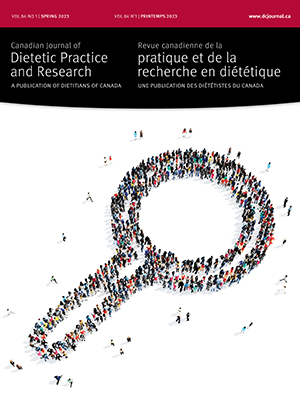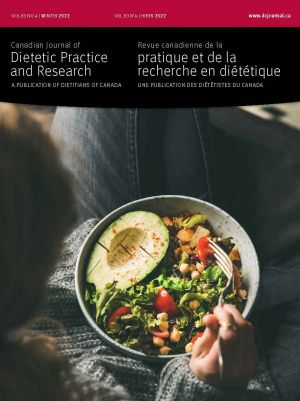Volume 77 • Number 1 • March 2016
Chair's Message
Editor's Message
Original Research
Purpose: Few questionnaires to test nutrition knowledge and attitudes of older adults living independently in the community have been developed and tested to assess self-management tools such as Nutri-eSCREEN and other education programs. This study is a first step in the development of a questionnaire designed to evaluate the nutrition knowledge and attitudes of independent older adults (NAK-50+). Methods: The steps involved in this study were: (i) drafting initial questions based on the content of the Nutri-eSCREEN education material, (ii) using cognitive interviewing to determine if these questions were understandable and relevant (n = 9 adults ≥50 years of age), and (iii) completing test–retest reliability in a convenient community sample (n = 60 adults ≥50 years of age). Intra-class coefficients (ICC) and kappa were used to determine reliability. Results: A 33-item questionnaire resulted from this development and analysis. ICC for the total score was 0.68 indicating good agreement and thus initial reliability. Conclusions: NAK-50+ is a face valid and reliable questionnaire that assesses nutrition knowledge and attitudes in independent adults aged ≥50 years. Further work to determine construct validity and to refine the questionnaire is warranted. Availability of the questionnaire for this age group will support rigorous evaluation of education and self-management interventions for this segment of the population.
Purpose: To assess the consumer food environment in restaurants in Saskatoon, using the Nutrition Environment Measures Survey for Restaurants (NEMS-R), to examine differences by neighbourhood distress level and to reflect on the need for further refinement of the assessment of restaurant consumer food environments. Methods: Neighbourhoods were classified as low, middle, or high distress level based on the socioeconomic indicators (income, employment, and education) in the Material Deprivation Index. Differences in restaurant consumer food environments, indicated by mean NEMS-R total and sub-scores, were examined by various restaurant categories and by varying neighbourhood distress levels. Results: Chain coffee shops and pita and sandwich restaurants had higher NEMS-R totals and “Healthy Entrées” sub-scores; however, burger and chicken restaurants and pizza restaurants had more barriers to healthful eating. Although restaurants in lower distress level neighbourhoods generally rated healthier (higher NEMS-R scores), only a few measures (such as “Facilitators” and “Barriers”) significantly differed by neighbourhood distress level. Conclusions: The findings highlight the importance of developing interventions to improve restaurant consumer food environments, especially in neighbourhoods with higher distress levels. The results suggest that reliable measures of the consumer food environment could be developed beginning with what can be measured by NEMS-R.
Purpose: To adapt and validate a survey instrument to assess the nutrition environment of grab-and-go establishments at a university campus. Methods: A version of the Nutrition Environment Measures Survey for grab-and-go establishments (NEMS-GG) was adapted from existing NEMS instruments and tested for reliability and validity through a cross-sectional assessment of the grab-and-go establishments at the University of Toronto. Product availability, price, and presence of nutrition information were evaluated. Cohen’s kappa coefficient and intra-class correlation coefficients (ICC) were assessed for inter-rater reliability, and construct validity was assessed using the known-groups comparison method (via store scores). Results: Fifteen grab-and-go establishments were assessed. Inter-rater reliability was high with an almost perfect agreement for availability (mean κ = 0.995) and store scores (ICC = 0.999). The tool demonstrated good face and construct validity. About half of the venues carried fruit and vegetables (46.7% and 53.3%, respectively). Regular and healthier entrée items were generally the same price. Healthier grains were cheaper than regular options. Six establishments displayed nutrition information. Establishments operated by the university’s Food Services consistently scored the highest across all food premise types for nutrition signage, availability, and cost of healthier options. Conclusions: Health promotion strategies are needed to address availability and variety of healthier grab-and-go options in university settings.
Perspectives in Practice
nutritionDay is a 1-day cross-sectional survey identifying how nutrition care is provided. This paper provides results of the first 2 Canadian nutritionDay surveys. In November 2010 and 2011, data from standardized questionnaires were collected from 193 units in Canadian hospitals consisting of unit demographics and patient information including weight history, health status, nutrition assessment, nutrition therapy, food intake and 30-day outcomes. Results indicated that overall, 46% of the 1905 patients reported weight loss in the previous 3 months, and in half of these it was greater than 5 kg. Only 50% of the units had nutrition teams and nutrition therapy was provided to less than 14% of patients. More than 50% of patients ate less than normal in the previous week and 57% ate less than half of their meal on nutritionDay. Within the next 30 days the majority of patients went home, 10% remained in hospital, and 6% were readmitted. In this study, nutritionDay provided relevant information on nutrition assessment, weight history, food intake, nutrition therapy, length of stay, and outcomes in participating Canadian institutions. Data from 2010 and 2011 can help to both reflect on current practices and define continuous improvements through benchmarking with the overall goal of mitigating suboptimal nutrition intake during hospitalization.
Social media has become a popular platform for reputable health organizations to disseminate health information to the public. However, future health professionals may receive little training in social media communication. To train future dietetic professionals, we incorporated a social media assignment into a Communications course curriculum to facilitate effective use of social media for the profession. For the assignment, students were instructed to make 2 posts on Facebook. The posts were due 3 weeks apart so that students received feedback on their first post before making their second post. To demonstrate the type of social media communication commonly used by reputable health organizations, the first post raised awareness or provided nutrition education. The second post used Facebook’s “comment” feature, to respond to another student’s first post, demonstrating the use of social media for community engagement. Both posts included a hyperlink that the user could click to get more information. Students were evaluated on the hook, main points, professionalism, credibility, and effectiveness of inviting the reader to the hyperlinked website and its ease of navigation. Dietetics educators should be encouraged to incorporate social media education into their curriculums for the benefit of future dietitians and their clients.
In 2014, a national initiative aimed at defining a research agenda for nutrition and mental health among diverse stakeholders was completed and included insights from more than 300 registered dietitians. This study explores the data from dietitians based on their years of practice, mental health experiences, and community of practice in relationship to identified mental health and nutrition research priorities. Analysis of numerical data (n = 299) and content analysis of open-ended responses (n = 269) revealed that respondents desired research for specific mental health conditions (MHCs), emotional eating, food addiction, populations with special needs, and people encountering major life transitions (e.g., recovery from abuse, refugees). Findings from the quantitative and textual data suggested that dietitians want research aimed at addressing the concerns of those in the community, fostering consumer nutrition knowledge and skill acquisition, and developing services that will impact quality of life. Subgroup analysis indicated that dietitians: (i) in early years of practice want information about specific MHCs; (ii) living in smaller towns and rural areas want data about the cost benefits of dietetics practice in mental health; and (iii) who also had additional stakeholder roles (e.g., service provider) selected priorities that address gaps in mental health services. This study highlights opportunities to tailor nutrition and mental health research that advance dietetics practice.
Barriers to dietitians' participation in research include lack of time, self-perceived competence, confidence, administrative support, and funding. Providence Health Care, a multi-site health care organization in Vancouver, British Columbia implemented the Practice-based Research Challenge (RC), a 1-year research program, to support interdisciplinary teams of nurses and allied health professionals to conduct practice-relevant research projects. Funding, mentoring, and research education were provided to research teams. From 2011 to 2015, 37% of all dietitians in the organization were involved in the RC in 4 cohorts of the 1-year program. An online survey was conducted to understand these dietitians' interest and experience in the RC. The survey results indicated that the major reasons for participating in the program were to increase knowledge, improve patient care, and to work on a project of interest. Respondents thought they gained knowledge, enhanced professional development, and improved patient care. A majority stated they would likely conduct future research. The RC enabled and supported dietitians' participation in research; infrastructure supports for research and enabling a culture of research participation are key contributors to promoting dietitians involvement in research.
To identify parental influences affecting micronutrient supplementation in children and adolescents (2–18 years of age) with Celiac Disease (CD), a multi-method (survey, focus groups) study was conducted. A 35-item questionnaire consisting of open- and closed-ended questions was launched nationally via Canadian Celiac Association internet sites. Five focus groups were conducted using a semi-structured interview guide. The survey and semi-structured interview guide content was vetted for face and content validity. Thematic analyses were conducted on the focus group content and open-ended survey questions, and χ2 and Fischer’s exact analysis were performed on closed-ended survey data. Survey respondents were predominantly mothers (97%) of female children (80 F, 49 M) between the ages of 9–12 (31%) with CD, residing in western provinces (55%) with a combined family income ≥$100 000/year (63%). Seventy-seven percent of parental respondent’s children or adolescents consumed micronutrient supplements, for 1–5 years (52%), 7 days a week (65%), as both multi-vitamin and single vitamin preparations (40%). Parental influences on child micronutrient use included health beliefs and knowledge, parental supplement use, supplement characteristics, age of child (above or below 13 years), household routines, and provincial residential status (P < 0.05). Parents relied on health professional recommendation (69%; MD, RD) and the internet (21%) as sources of information regarding child micronutrient supplementation. Parental health beliefs and knowledge, socio-demographic factors, and practitioner recommendation influence micronutrient supplement use in children and adolescents with CD.
Policy Statement
OPEN ACCESS
It is the position of the Academy of Nutrition and Dietetics, Dietitians of Canada, and the American College of Sports Medicine that the performance of, and recovery from, sporting activities are enhanced by well-chosen nutrition strategies. These organizations provide guidelines for the appropriate type, amount, and timing of intake of food, fluids, and supplements to promote optimal health and performance across different scenarios of training and competitive sport. This position paper was prepared for members of the Academy of Nutrition and Dietetics, Dietitians of Canada (DC), and American College of Sports Medicine (ACSM), other professional associations, government agencies, industry, and the public. It outlines the Academy's, DC's and ACSM's stance on nutrition factors that have been determined to influence athletic performance and emerging trends in the field of sports nutrition. Athletes should be referred to a registered dietitian/nutritionist for a personalized nutrition plan. In the United States and in Canada, the Certified Specialist in Sports Dietetics (CSSD) is a registered dietitian/nutritionist and a credentialed sports nutrition expert.










